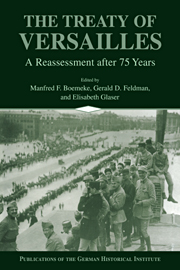Book contents
- Frontmatter
- Introduction
- Prologue: 1919-1945-1989
- PART ONE PEACE PLANNING AND THE ACTUALITIES OF THE ARMISTICE
- PART TWO THE PEACEMAKERS AND THEIR HOME FRONTS
- PART THREE THE RECONSTRUCTION OF EUROPE AND THE SETTLEMENT OF ACCOUNTS
- 11 The Minorities Question at the Paris Peace Conference: The Polish Minority Treaty, June 28, 1919
- 12 The Rhineland Question: West European Security at the Paris Peace Conference of 1919
- 13 The Polish Question
- 14 Smoke and Mirrors: In Smoke-Filled Rooms and the Galerie des Glaces
- 15 The Making of the Economic Peace
- 16 The Balance of Payments Question: Versailles and After
- 17 A Comment
- PART FOUR THE LEGACY AND CONSEQUENCES OF VERSAILLES
- PART FIVE ANTECEDENTS AND AFTERMATHS REFLECTIONS ON THE WAR-GUILT QUESTION AND THE SETTLEMENT
- Bibliography
- Index
12 - The Rhineland Question: West European Security at the Paris Peace Conference of 1919
from PART THREE - THE RECONSTRUCTION OF EUROPE AND THE SETTLEMENT OF ACCOUNTS
Published online by Cambridge University Press: 05 January 2013
- Frontmatter
- Introduction
- Prologue: 1919-1945-1989
- PART ONE PEACE PLANNING AND THE ACTUALITIES OF THE ARMISTICE
- PART TWO THE PEACEMAKERS AND THEIR HOME FRONTS
- PART THREE THE RECONSTRUCTION OF EUROPE AND THE SETTLEMENT OF ACCOUNTS
- 11 The Minorities Question at the Paris Peace Conference: The Polish Minority Treaty, June 28, 1919
- 12 The Rhineland Question: West European Security at the Paris Peace Conference of 1919
- 13 The Polish Question
- 14 Smoke and Mirrors: In Smoke-Filled Rooms and the Galerie des Glaces
- 15 The Making of the Economic Peace
- 16 The Balance of Payments Question: Versailles and After
- 17 A Comment
- PART FOUR THE LEGACY AND CONSEQUENCES OF VERSAILLES
- PART FIVE ANTECEDENTS AND AFTERMATHS REFLECTIONS ON THE WAR-GUILT QUESTION AND THE SETTLEMENT
- Bibliography
- Index
Summary
The solution of the Rhineland question at the Paris Peace Conference of 1919 left no one happy. Here, in practical terms, lay the cornerstone of the whole diplomatic edifice. Could a peace fashioned through the compromise of fundamentally opposing views prevent Germany from breaking out on the world again or developing the ambition to do so?
Jacques Bainville touched on the nub of the difficulty in his disabused apothegm: the treaty appeared “too gentle for all that is in it which is harsh.” Notwithstanding the outcome on the battlefield, the disproportion between French and German power loomed almost as large as ever. France had suffered a demographic holocaust. Ten northeastern departments of the country lay devastated. By contrast, Germany retained the most technologically skilled population in Europe. Its formidable industrial resources remained intact. Could military dispositions provide satisfactory containment?
The French obtained a three-stage, fifteen-year occupation of the Rhineland. But that occupation would lose much of its value as a security guarantee when the Allies evacuated the Cologne zone five years after the treaty took effect. It would end at the latest in 1935, when the French faced their greatest manpower deficit and with the planned reparations schedule still only half fulfilled. The United States and Britain undertook in principle to come to France's aid in the event of a new attack.
- Type
- Chapter
- Information
- The Treaty of VersaillesA Reassessment after 75 Years, pp. 275 - 312Publisher: Cambridge University PressPrint publication year: 1998
- 7
- Cited by

